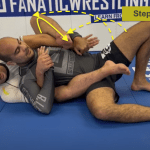Back Control is a coveted position because this can be one of the best-controlling positions against your opponent, a good Back Control can lead to many submissions as well as other even better positions like Full Mount hence the ability to have good control is crucial
Back Control is done several ways or several schools of thought and there is no right way, it depends on the situation when you roll, tournament or drilling. Here at The Lab, we’ll cover some basic guidelines to achieving good control. The first thing we’ll establish is that we’ll approach this to a Back Take position. Check out the following
- Step 1. When you ‘take’ your opponent/training partner’s back, is important that you ‘glue’ your chest against his/her back (see the dotted line) this will allow you to follow or prevent any attempt to escape. Two of your legs over the opponent’s legs this is called Hooks, you can have one hook (this means one leg) or both like in the image, as well as one arm under the opponent’s arm and the other arm over his shoulder, you can grip your hands commonly known as seat belt hold.
- Step 2. In the case that you fall to the side, this occasionally happens, either because of your opponent’s defense or you setting him/her up for a submission. The best control is not to allow your opponent to move to the right or left his/her axis (see image) As you can see, the elbow positions and hooks will prevent any movement from your opponent
- Step 3. There are a plethora of conditions but the basics are listed in steps 1 and 2, We’ll explore one variation. When we are with one arm over your trainer partner’s shoulder, you can pursue a choke, and their reaction will be to grab the attacking side (see the picture)
- Step 4. When there is a Step 3 you can use it to your advantage by pushing down his torso.
- Step 5. At the same time, you perform Step 4 swing your leg over trapping both your and your opponent’s arms.
- Step 6. Is important that you put pressure on your heel so you can pull out your arm, freeing you to a possible submission, and better control since you disabled one arm.
Some of these moves require good elasticity, and may not apply to your game, but some adjustments can be made to complete most positions. Please review Professor Andrew Wiltse’s great video.




















Comments 0